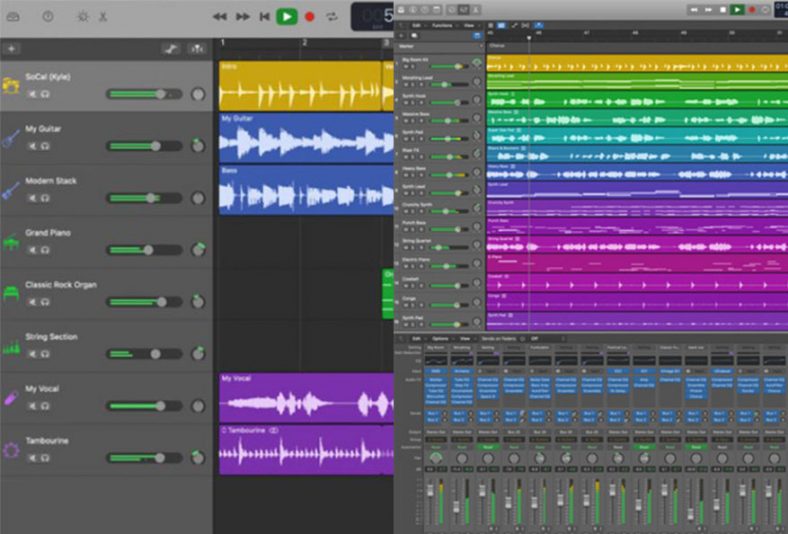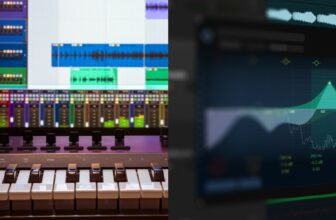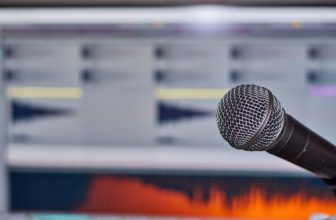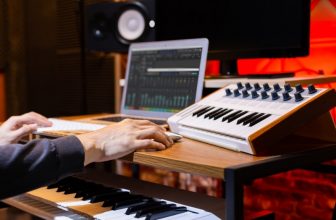Garageband vs Logic Pro – What’s the Difference?

Garageband is a free digital audio workstation (DAW) aimed at beginners and has basic features, whereas Logic Pro is a paid DAW aimed at professionals that stands up against any other full-fledged music program on the market. Both are exclusively available for Mac.
In a way, Garageband and Logic Pro are made of the same stuff. Garageband was modeled after Logic Pro when the latter (then branded Emagic) was acquired by Apple in 2002. Apple took inspiration from Logic Pro’s functionalities to build a free, much-simpler alternative—an easy-to-use program, ideal for learning about the ins and outs of music production.
But while Garageband and Logic Pro are similar, they serve completely different needs. Garageband exists so any Mac user can create music using a basic, accessible program. Logic Pro, on the other hand, is made for experienced producers who are trying to make a living off their craft.
Contents
The similarities between Garageband and Logic Pro
Before exploring what exactly makes Garageband and Logic Pro so different, it’s important to mention their similarities. Both are exclusively available for Mac, both feature an identical interface, both have flawless VST integration, and both work pretty much the same way. In short, anyone who knows how to work with Garageband should know the basics of working with Logic Pro.
The crucial difference between the two programs, however, is that Garageband is an entry-level DAW, whereas Logic Pro is a complete, pro-level DAW. Ideally, Apple is trying to seduce its users into music production with Garageband so they can later sell them Logic Pro—which is basically an advanced version of Garageband.
Key differences between Garageband and Logic Pro
- Garageband is a free DAW, while Logic Pro is a paid DAW. Every Mac user gets Garageband for nothing, but a Logic Pro license costs a few hundred dollars.
- Garageband is aimed at entry-level producers, while Logic Pro features all the advanced features you’d expect from a pro-level DAW.
- Garageband’s stock plugins are very limited. Getting access to the full power of the stock plugins included in Garageband requires a Logic Pro license.
- Some useful feature windows are not included in Garageband. These include, most notably, the mixer window and the inspector window.
- Buses, groups, and send/return features are not included in Garageband. This can affect workflow severely, as any experienced music producer would know.
- Recording in Garageband is not ideal. Unlike Logic Pro, Garageband doesn’t have a feature for creating take folders, meaning it’s inconvenient for recording with a live band or singer.
Is Logic Pro worth the price?
If you know one or two things about music production and want to take your craft to the next level, you should buy a Logic Pro license. Logic Pro’s advanced features are often nuanced, but they make a crucial difference if you’re working daily on music projects.
Logic Pro offers a level of detail that simply doesn’t exist in Garageband. Garageband is perfect for learning the basics of music production because it doesn’t overwhelm you with too many advanced features. But while that’s one of the program’s biggest strengths, it’s also its biggest flaw.
Once you’ve played with Garageband for a while, and you’ve already come up with one or two interesting tracks, then you should invest in Logic Pro and take your skills to the next level. Garageband won’t cut it at a pro-level.
The names of the two DAWs are surprisingly telling: Garageband, like a garage band, is perfect for making some noise and having fun with friends. Logic Pro, on the other hand, is amongst the best DAWs in the world and gives you the tools you need to do everything—from recording live bands in a professional studio setup to mixing a number-one hit.
The crucial workflow differences between Garageband and Logic Pro
Workflow matters in music production because it can help you to save time, CPU, and come up with better-sounding tracks. While Logic Pro offers all the advanced workflow features you’d expect from a professional DAW, Garageband is overly preset-dependent and can be annoyingly limited.
These are the crucial workflow differences that make Logic Pro much better than Garageband:
You can’t select multiple tracks in Garageband
Being able to select multiple tracks in a DAW is a must, but this is not possible if you’re using Garageband. Selecting multiple tracks is useful for, for instance, lowering the volume of more than one track by the same amount at once. This can easily be achieved if you’re using Logic Pro.
In Garageband, you’d need to manually lower the volume of each separate track by the same amount to achieve the same effect.
You can’t create buses or groups in Garageband
Buses are a great way of processing multiple tracks using the same effect(s). Imagine you have five bass tracks in your music project, and you want to process each one of them using the same delay effect. In Logic Pro, it’s easy: you can create a bus or even a group including the five bass tracks and add the delay effect to the bus.
To achieve the same effect in Garageband, you’d need to process each track with its separate delay plugin (even if the delay is the same). You know what this means: a huge waste of your time and an even bigger waste of your Mac’s CPU.
You don’t have sends/returns in Garageband
A similar issue. Sends/returns work as auxiliary tracks that help you to add different levels of the same effect to multiple tracks in the mix. This is possible in Logic Pro, but not in Garageband. Pretty much every DAW incorporates sends/returns for a reason: because they help music producers to save time and CPU—and can also be used creatively to great effect.
You only have two mouse tools in Garageband
Mouse tools are great for DAWs because they allow producers to customize their workflow and edit audio and MIDI tracks much faster. In Garageband, there are only two mouse tools available: the cursor tool (which allows you to click on parameters), and the pencil tool (which allows you to quickly draw MIDI notes and automation points).
These two mouse tools are very useful, but they’re massively underwhelming if you consider the additional mouse tools included in Logic Pro. With Logic Pro, you also have access—for example—to an eraser tool (for quickly deleting audio/MIDI information), a scissors tool (for quickly splitting audio/MIDI tracks), or a fade tool (for quickly drawing volume fades at the start and end of audio tracks).
You don’t have a mixer window in Garageband
You can see Garageband’s mixer in the arrangement view. There, you can easily lower the volume of a track and change other parameters, such as panning. However, you can’t access the mixer as a separate window unless you have a Logic Pro license.
Why does this matter? Visually, it’s very useful to have a separate mixer window, which can be used to control volume and panning on the go and gives you a strong reference of your mix’s overall balance. The mixer window in Logic Pro also allows you to copy effect racks from one track to the other by selecting ‘Copy Channel Strip Settings.’ This feature isn’t available in Garageband.
You don’t have an inspector window in Garageband
Like the mixer window, the inspector window is very useful for visualizing detailed data about each of the tracks in the mix and making informed decisions on the go. In Logic Pro, it’s also the section that allows you to check your sends/returns.
Sadly, the inspector window isn’t included in Garageband.
You don’t have a latch feature in Garageband
The latch feature in Logic Pro is a workflow wonder because it allows you to record automation changes (whether you’re creating such changes using your mouse or a MIDI controller’s knob) and edit them with as much detail as you want.
The latch feature doesn’t exist in Garageband, meaning it’s way harder—and much more time-consuming—to automate parameters. Recording automation is crucial for obtaining a smooth-changing, natural-sounding vibe, especially if you’re working with software synthesizers.
Other crucial differences between Garageband and Logic Pro
Stock plugins
It’s not wrong to say that Garageband and Logic Pro feature the same stock plugins. But in a way, that’s a lie. Garageband and Logic Pro have the same compressor (for example), but its features are very limited in Garageband.
When it comes to stock plugins, Garageband puts simplicity over function: it wants to present its users not with the best possible version of a plugin, but with the simplest possible version of a plugin.
The noise gate makes for a laughable example. While Logic Pro’s noise gate includes controls for threshold, reduction, attack, hold, release, or lookahead, Garageband’s noise gate features just one knob! If you’re working at a pro-level, one knob doesn’t give you the options you need to convincingly shape the audio dynamics of a song.
Recording
The recording process is a big part of making music. Some music producers make a living by recording live bands in their studios. Garageband allows for recording but misses a crucial function that’s almost mandatory in today’s day and age: a feature for creating take folders.
Take folders are a music engineer’s crucial component. They allow for a process known as creating comps, i.e., saving several recorded takes in the same track. This means that a music producer can loop a small section, hit record, and save different takes recorded by a musician in that same section. To achieve this in Garageband, one would need to create a new, duplicate track for each take recorded by the musician.
Garageband is also poor for recording because it doesn’t have latency control. While latency is automatically adjusted in the program, experienced music producers should always have access to their latency settings. Often, latency controls need to be adjusted to deal with recording latency and CPU issues.
Pitch correction
Pitch correction isn’t the defining factor that makes a DAW good or bad. But the differences in Garageband’s and Logic Pro’s pitch correction feature are so emblematic of what separates the two DAWs that I felt like I needed to highlight them.
In Garageband, you can pitch-correct vocals with one single fader that allows you to choose anywhere between 0% pitch correction and 100% pitch correction. Think of it as a built-in AutoTune, except the AutoTune only has one adjustable parameter.
In Logic Pro, you can pitch-correct vocals syllable by syllable. You can define the amount of pitch correction attributed to each syllable, define vowel extension, shape formants, and more. It’s like having a built-in Melodyne VST, with all the essential parameters that make it the go-to tool for modern-day pitch correction.
Verdict
Every experienced music producer will tell you: it’s not about the DAW, it’s about your skills and hard work. But if you want to be at the top of your game, you also need a top-level DAW. Garageband is free, and that’s amazing considering everything it’s capable of, but it’s not quite there if your goal is to succeed as a pro in the music industry.
Buying a Logic Pro license after learning how to use Garageband is the leap you need to take your music production skills from boy to man, from girl to woman. If you’ve been using Garageband for a while and you feel like it’s no longer up to your high standards, it’s probably time to get a Logic Pro license.





